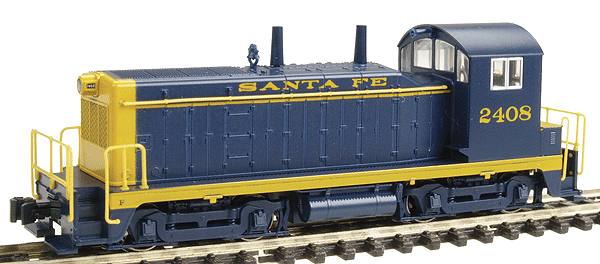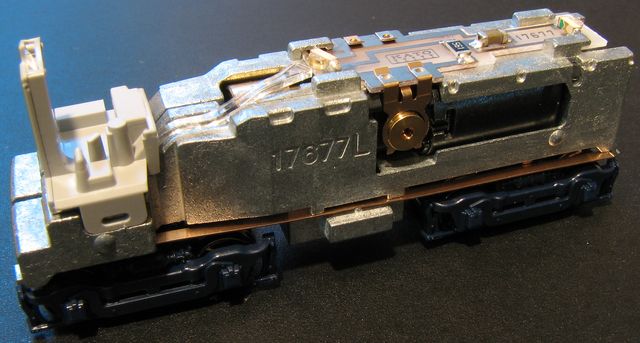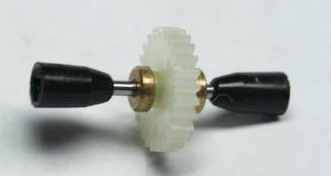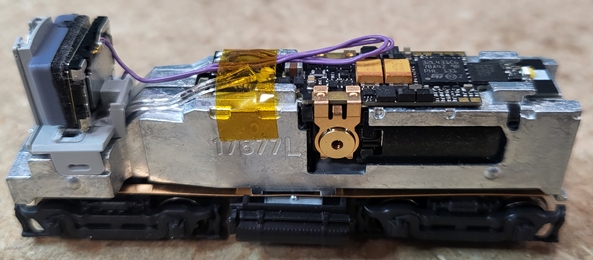

Introduced: 2007 (DCC-Ready version), 2013 (DCC-Equipped version) and 2025 (DCC-Sound version)
Excluding their involvement in the Con-Cor/Rivarossi "cow and calf" switchers of the 70's and 80's, this was actually Kato's first stab at an N scale yard switcher. And not surprisingly, they came up with one flat out gorgeous looking locomotive. Better still, it's an impressive performer as well.

The mechanism sports all of the features one normally associates with "modern" diesel models - IE, split-frame / all-metal / DCC-Ready chassis, 3-pole / skew-wound motor (with one flywheel), low-friction drive, bi-directional LED lighting, all-wheel drive and pickup (no traction tires), blackened / low-profile wheels, shell-mounted automatic couplers, all-plastic gearing, etc. Additional goodies include cab interior detailing, lit numberboards and Kato's "shock absorber" construction.
Performance is sensational - smooth, quiet and responsive at all throttle levels, awesome slow speed performance, great pickup (no stalls over turnouts), and overall just a superb runner. Yes, I've read that it won't pull quite as many cars as, say, Life-Like's SW1200. But when you're talking about the difference between pulling 12 cars and pulling 15, you've probably strayed into nitpick country. I've also read complaints about noisiness, which seems like more nitpicking to me. I'll admit that this model is not as whisper quiet as a typical Kato diesel (emitting a noticeable whine when running), but compared to the coffee-grinders of yore, it's plenty quiet enough for an "A" rating here. In any case, I'm told that additional gear lubrication will go a long way towards eliminating the noise.
One potential problem with these models relates to the spur gear on the driveshaft. Evidently it is held in place solely by friction and can work itself loose and start slipping on the shaft. I've never had this happen to mine, but I've read enough reports from others to make it worth mentioning. The reported solution is to roughen up the shaft where the gear sits and then put a drop of red Loctite on it.

Digitrax offers a drop-in decoder repacement for this loco's light board (DN123K3). Installation is relatively painless, with the only only semi-tricky part involving moving the motor clips from the lightboard to the decoder. Also, I had to trim a tiny bit off one end of the decoder PC board to get the frame contacts to slide all the way into the slots on the chassis. All in all though, a pretty simple install. Beginning in 2013, Kato's "Kobo" division started offering these models with pre-installed decoders (the Train Control Systems K3D3).
DCC-Sound versions were released in 2025. As pictured below, the only real change is that much of the cab interior detail has been hacked away in order to provide room for the speaker -

According to an insert included in the box, the decoder is a Zimo "NW2_A246" (presumably custom-made for this model) -

Now, I don't know what sort of "keep alive" technology is employed by this decoder, but whatever it is, it is flat out sensational. I took my brand new model out of its box, put it on the rails (which hadn't been cleaned in recent memory), set the the throttle to speed step 1, and then proceeded to watch that baby run around the rails at a barely perceptible crawl for 24 hours, and without so much as a single hiccup! Simply amazing!
Prototype information -
EMD's NW2 switcher's lifetime was nearly cut short just three years after its introduction, with the establishment of the War Production Board in 1942, which dictated that EMD was to halt all production of switching locomotives, manufacturing only road diesels during the years of 1942 to 1945. However, such was the popularity of this end cab switching locomotive that after the restriction was lifted, the NW2 sprung back as many railroads placed orders for this little 1000hp powerhouse; today these locomotives can still be found enjoying continued service in rail yards.
Kato's own N scale NW2 replicates each and every rivet of prototype detail with pinpoint precision, while emphasizing low-speed, high-power pulling. It also features directional headlights (without any of the lightpiping equipment intruding on the interior cab detail), low profile wheels, illuminated numberboards, and Kato magnetic knuckle couplers.
To remove the shell, simply use a couple of toothpicks (or small screwdrivers or whatever) to pry the sides of the shell away from the chassis. The shell should lift off readily at that point.
Grade: A
Reviewed: 05/07 Model Railroader ("Kato's new N scale switch engine is an accurate representation of a pre-WW II EMD NW2. The ready-to-run model includes cab interior details, thin cross-section handrails, and a newly designed and very compact drive mechanism that performs well at slow speed... Kato's model is within scale inches of the prototype dimensions, including a correct 7-foot hood width. The model has the key spotting features of an early production NW2, including a double-step taper where the hood meets the cab, and plain hood access doors... The model has the correct AAR type B trucks with solid bearings. Large, flush-fitting windows in the cab show off the interior details. A cleverly concealed light-piping arrangement illuminates the rear headlight without intruding into the cab's interior... The body is secured by cast-in lugs in front and back, but it lifts off easily to reveal a split-frame mechanism with a top-mounted PC board... The drive mechanism is a new design for Kato. The motor and single flywheel are offset to the front and mounted above a central gear box equipped with twin drive shafts connected to gears in the trucks. As with many recent Kato locomotives, each axle is individually sprung. The mechanism is extremely compact, and the locomotive operates smoothly at slow speeds. The Kato NW2 started at 1.9 volts and crept along at less than 2 mph without cogging. At 12 volts, the engine hit 109 mph, far above the prototype's 60 mph gearing. Pulling power was a modest .48 ounce, equal to about 11 cars... The switcher pulled a nine-car train around 9.75" curves with just a hint of wheel slip... With fine details and impressive slow-speed performance, the Kato NW2 is an excellent replica of an important transition-era locomotive. ATSF, $100")